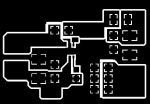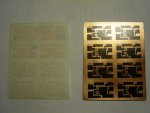phenol said:

thats too good to be true. the first paper i tried with was exactly label backing. the toner did stick to it but i could easily peel it off with a nail. now im wondering why it didnt transfer to the PCB...maybe i didnt apply the exact pressure long enough...mayb the pcb surface had poor adhesive properties... or the HP toner sux. next time im going to preheat the pcb
These boards are actually the first time, that i ever etched my own circuits... And i'm amazed by the results myself.. The first try was almost exactly as succesfull.. The second was not, because i heated the board so long, untill the copper separated, but the third was perfect, as you can see...
Yes, you can scratch the toner off the label backing with a nail.. That's why it transfers so good, after ironing.. The only time it didn't transfer well was, when i was peeling it off warm. How did you do it? EDIT: Oh, you didn't pre heat the board! that's the problem... When you preheat the board, the sheet immediatelly sticks to it.
Oh, and i use steel wool (what's it called?) to scratch the entire pcb, before transfer of course, so it's surface is rough.. Then i clean it with alcohol, after that it's just the standard transfer practice:
- scratch the board with steel wool in circles, to make it's surface less smooth and then clean with alcohol (or any other solvent)
- 30-40 seconds warming up the board with the iron, and lots of pressure, moving it around, to heat it evenly
- carefully apply the sheet, so that it's perfectly flat
- put another paper over it and iron for around 3 minutes with a LOT of pressure, moving the iron around to heat evenly
- let it cool off completelly! (the page i linked to recommends doing it warm, but i ruined a board this way.. cold is better)
- peel off
- remove toner with acetone and the steel wool thingy
And if there is an area where it didn't transfer well, put it back, iron some more, cool down and peel off. (but i didn't have to do this even once)
Moving the iron around is important, because it is not evenly hot itself.. I measured the steel plate with an IR thermometer, and there are hot spots, and cooler spots..
When done properly, the label backing sheet comes off almost by itself and you only have to fix some minor spots with the marker, as you can see in the pic.
My main problem was, that the toner didn't want to stick to the label backing in the first place.. But i already explained the solution for that.
At first i printed, scratched the ink off, cleaned with a paper towel and printed again on the same area, but then i decided to see, what happens if i just scratch the label backing with a credit card and wipe it with a paper towel (before printing anything), and it worked just as well, or even better.
It works so great, that i think i'll use it for work, when smaller numbers are required...
I just need to find a better label backing.. This one is very old, and has labels for cassetes. Unfortunatelly, this means it has indentations, where the cassete shaped cutouts are.. This sometimes causes rounded lines, where the toner doesn't transfer. I think the less labels on the sheet, the better, but A4 labels sometimes have the backing in three parts, which is useless.





